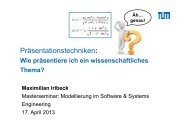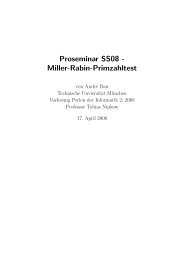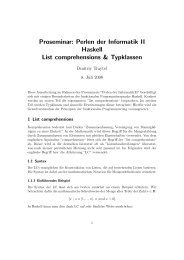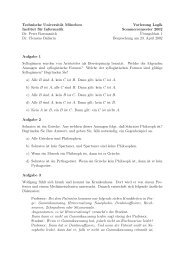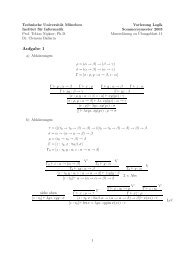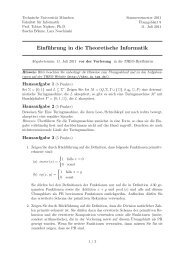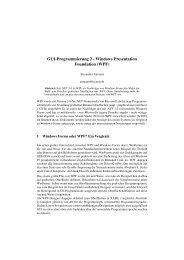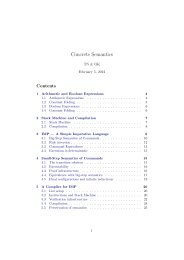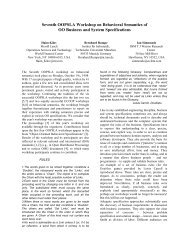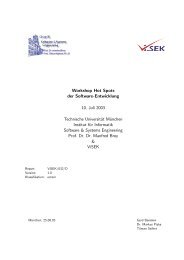Fig. 1.The original file (left), its normalization (center), <strong>and</strong> the corresponding clone index (right).indices which allow persisting the clone index over time <strong>and</strong>processing amounts of code which are too large to fit into mainmemory. The latter may be based on database systems, or onone of the many optimized (<strong>and</strong> often distributed) key-valuestores [37], [38].In Fig. 1, the correspondence between an input file “X.j” 4<strong>and</strong> the clone index is visualized for a chunk length of 5. Thefield which requires most explanation is the sequence hash.The reason for using statement sequences in the index insteadof individual statements is that the statement sequences aremore unique (two identical statement sequences are less likelythan two identical statements) <strong>and</strong> are already quite similar tothe clones. If there are two entries in the index with the samesequence, we already have a clone of length at least n. Thereason for storing a hash in the index instead of the entiresequence is for saving space, as this way the size of the index isindependent of the choice of n, <strong>and</strong> usually the hash is shorterthan the sequence’s contents even for small values of n. We usethe MD5 hashing algorithm [39] which calculates 128 bit hashvalues <strong>and</strong> is typically used in cryptographic applications, suchas the calculation of message signatures. As our algorithmonly works on the hash values, several statement sequenceswith the same MD5 hash value would cause false positivesin the reported clones. While there are cryptographic attackswhich can generate messages with the same hash value [40],the case of different statement sequences producing the sameMD5 hash is so unlikely in our setting, that it can be neglectedfor practical purposes.C. <strong>Clone</strong> Retrieval<strong>Clone</strong> retrieval is the process of extracting all clones for asingle file from the index. Usually we assume that the file iscontained in the index, but of course the same process canbe applied to find clones between the index <strong>and</strong> an externalfile as well. Tuples with the same sequence hash alreadyindicate clones with a length of at least n (where n is theglobally constant chunk length). The goal of clone retrievalis to report only maximal clones, i.e., clone groups whichare not completely contained in another clone group. Theoverall algorithm, which calculates the longest subsequencesof duplicated chunks, is sketched in Fig. 2 <strong>and</strong> explained inmore detail next.The first step (up to Line 6) is to create the list c ofduplicated chunks. This list stores for each statement of the4 We use the name X.j instead of X.java as an abbreviation in the figures.1: function report<strong>Clone</strong>s (filename)2: let f be the list of tuples corresponding to filenamesorted by statement index either read fromthe index or calculated on the fly3: let c be a list with c(0) = ∅4: for i := 1 to length(f) do5: retrieve tuples with same sequence hash as f(i)6: store this set as c(i)7: for i := 1 to length(c) do8: if |c(i)| < 2 or c(i) ˜⊆c(i − 1) then9: continue with next loop iteration10: let a := c(i)11: for j := i + 1 to length(c) do12: let a ′ := a˜∩c(j)13: if |a ′ | < |a| then14: report clones from c(i) to a (see text)15: a := a ′16: if |a| < 2 or a ˜⊆c(i − 1) then17: break inner loopFig. 2.Fig. 3.<strong>Clone</strong> Retrieval AlgorithmLookups performed for retrievalinput file all tuples from the index with the same sequence hashas the sequence found in the file. The index used to access thelist c corresponds to the statement index in the input file. Thesetup is depicted in Fig. 3. There is a clone in X.j of length10 (6 tuples with chunk length 5) with the file Y.j, <strong>and</strong> a cloneof length 7 with both Y.j <strong>and</strong> Z.j.In the main loop (starting from Line 7), we first checkwhether any new clones might start at this position. If thereis only a single tuple with this hash (which has to belongto the inspected file at the current location) we skip this loop
iteration. The same holds if all tuples at position i have alreadybeen present at position i − 1, as in this case any clone groupfound at position i would be included in a clone group startingat position i − 1. Although we use the subset operator in thealgorithm description, this is not really a subset operation,as of course the statement index of the tuples in c(i) will beincreased by 1 compared to the corresponding ones in c(i−1)<strong>and</strong> the hash <strong>and</strong> info fields will differ.The set a introduced in Line 10 is called the active set <strong>and</strong>contains all tuples corresponding to clones which have not yetbeen reported. At each iteration of the inner loop the set ais reduced to tuples which are also present in c(j); again theintersection operator has to account for the increased statementindex <strong>and</strong> different hash <strong>and</strong> info fields. The new value isstored in a ′ . <strong>Clone</strong>s are only reported, if tuples are lost inLine 12, as otherwise all current clones could be prolongedby one statement. <strong>Clone</strong> reporting matches tuples that, aftercorrection of the statement index, appear in both c(i) <strong>and</strong> a;each matched pair corresponds to a single clone. Its locationcan be extracted from the filename <strong>and</strong> info fields. All clonesin a single reporting step belong to one clone group. Line 16early exits the inner loop if either no more clones are startingfrom position i (i.e., a is too small), or if all tuples from ahave already been in c(i − 1), corrected for statement index.In this case they have already been reported in the previousiteration of the outer loop.This algorithm returns all clone groups with at least oneclone instance in the given file <strong>and</strong> with a minimal lengthof chunk length n. Shorter clones cannot be detected withthe index, so n must be chosen equal to or smaller than theminimal clone length (typically 7 or 10). Of course, reportedclones can be easily filtered to only include clones with alength l > n.One problem of this algorithm is that clone classes withmultiple instances in the same file are encountered <strong>and</strong> reportedmultiple times. Furthermore, when calculating the clonegroups for all files in a system, clone groups will be reportedmore than once as well. Both cases can be avoided, bychecking whether the first element of a ′ (with respect to afixed order) is equal to f(j) <strong>and</strong> only report in this case.Complexity: For the discussion of complexity we denote thenumber of statements by |f| <strong>and</strong> the number of tuples returnedfor its i-th statement by |c(i)| (just as in the algorithm). Thenumber of tuples in the index is denoted by N. For the first partof the algorithm the number of queries to the index is exactly|f|+1. Assuming that a single query returning q elements canbe performed in O(q + log N), which is true for typical indeximplementations, the first part up to Line 6 requires at mosttime O( ∑ i|c(i)| + |f| log N).The set operations used in the algorithm are easily implementedin linear time if the sets c(i) are managed as sortedlists. Thus, the running time of the part starting from Line 7is bounded by O(|f| 2 max c(i)), which seems to be ratherinefficient. It should be noted, however, that the worst-caseis hard to construct <strong>and</strong> nearly never appears in real-worldsystems. For both the case that a file contains not a singleclone (i.e., |c(i)| = 1 for all i), <strong>and</strong> that an exact duplicateexists for a file but no clone to other files, the runtime ofthis part improves to O(|f|). As the overall performance ofthe clone retrieval algorithm strongly depends on the structureof the analyzed system, practical measurements are important,which are reported on in Sec. IV.D. <strong>Index</strong> MaintenanceBy the term index maintenance we underst<strong>and</strong> all stepsrequired to keep the index up to date in the presence ofcode changes. For index maintenance, only two operationsare needed, namely addition <strong>and</strong> removal of single files.Modifications of files can be reduced to a remove operationfollowed by an addition 5 <strong>and</strong> index creation is just addition ofall existing files starting from an empty index. In the indexbasedmodel, both operations are extremely simple. To adda new file, it has to be read <strong>and</strong> preprocessed to produceits sequence of normalized statements. From this sequence,all possible contiguous sequences of length n (where n isthe chunk length) are generated, which are then hashed <strong>and</strong>inserted as tuples into the index. Similarly, the removal ofa file consists of the removal of all tuples which contain therespective file. Depending on the implementation of the index,addition <strong>and</strong> removal of tuples can cause additional processingsteps (such as rebalancing search trees, or recovering freeddisk space), but these are not considered here.We may assume that preprocessing time of a file is linear inits size 6 . Depending on the index structure used, addition <strong>and</strong>removal of single tuples typically requires expected amortizedprocessing time O(1) (e.g., for hash tables), or O(log N)where N is the number of stored tuples (e.g., for search trees).Thus, the index maintenance operations can be expected to runin linear time or time O(|f| log N).E. Implementation ConsiderationsThere are two factors affecting the processing time requiredfor index maintenance <strong>and</strong> clone retrieval: the chunk size n,<strong>and</strong> the implementation of the clone index. The size of naffects both index maintenance, which is more efficient forsmall n, <strong>and</strong> clone retrieval, which benefits from larger n.Additionally, n has to be chosen smaller than the minimalclone length, as only clones consisting of at least n statementscan be found using the index. For practical purposes weusually choose n smaller than or equal to the minimal clonelength we are interested in. Values of n smaller than 5 typicallylead to a large number of tuples with the same hash value anthus severely affect clone retrieval.The index implementation is affected both by the choice ofthe data structure <strong>and</strong> the kind of storage medium used. As5 This simplification makes sense only if a single file is small compared tothe entire code base, which holds for most systems. If a system only consistsof a small number of huge files, more refined update operations would berequired.6 The preprocessing phase of most token-based clone detectors runs in lineartime, as both tokenization <strong>and</strong> normalization with constant look-ahead arelinear time operations.



